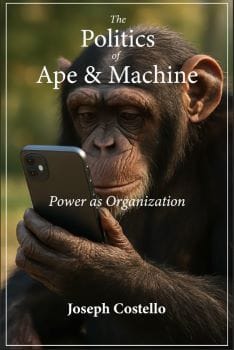AI Politics: Organizing Democracy

“Voting in fair and honest elections is a prerequisite for democratic self-rule. What may be even more important is a related civic duty: participation — engaging with fellow citizens and organizing in our communities. Joe Costello brings history and experience to bear on how we can help revive genuine government of, by, and for the people. It starts with participation, and builds outward from there.” Dan Gillmor, technology journalist, author, and Co-founder ASU News Co/Lab
AVAILABLE NOW
A funny thing happened on the way to the future or at least a future defined and determined by a handful of powerful technology corporations. Local politics began to revive across America. Not a moment too soon. There’s all sorts of reasons to be opposed to the latest tech-dream/nightmare marketed as AI. Opposition as the means to help revive and evolve our moribund democracy might be the greatest.
Let’s quickly go over the list of concerns. First, AI’s ecological impacts are atrocious. Its energy and water needs are causing concerns not just across the US but around the world. The NYT writes, AI Data Centers Create Fury from Ireland to Mexico.
How our Tech-Lords will conjure up more water remains unanswered, but energy wise, they’ve launched a push to build massive new quantities of electricity generation using gas and nuclear fuels. Like any good industry of the 19th and 20th centuries, it’s full speed ahead and damn any environmental impact. "Externalities," our AI aristocrats sniff.
Regarding the nuke push, the Valley is in pure vaporware mode, announcing all sorts of innovations such as Small Modular Reactors (SMR), or a nuke in every backyard and a chicken in every pot. The FT reminds,
“Past efforts to build SMR projects in the US have been plagued by delays and cost overruns. In 2023, NuScale — which has a design approved by US regulators — was forced to cancel a project after costs ballooned more than 120 per cent. The three operating SMRs worldwide, which are located in Russia and China, exceeded their original cost estimates by 300 to 400 per cent.”
But, as crypto proselytizers shrug and say, “What’s money in 2025?”
Certainly such concerns don’t hinder Valley AI fever. “SMR companies are increasingly signing power supply deals with utilities and tech companies, with over 32 gigawatts of commitments since 2023.”
Even better, the DOE announces,
“President Trump issued four executive orders (EOs) that direct the U.S. Department of Energy (DOE) to take a leading role in unleashing the American nuclear renaissance. Executive Order 14301 reforms and streamlines national laboratory processes for reactor testing at the Department and directs DOE to start a new pilot program to expedite the testing of advanced reactor designs.”
Nothing says confidence more than having a reality-tv, social media politician reforming and streamlining laboratory processes for reactor testing of the nukes destined for your backyard. There’s no simple rebooting a nuclear reactor gone awry. Nukes aren’t software or bilious rhetoric, they’re the most powerful hardware Homo sapiens have yet devised.
One might ask, even if we were to build all these next generation nukes, where would you get the fuel? Uranium is a rather precious metal needing to be “enriched” for utilization as fuel. Already, with no new reactors, “U.S. nuclear plants are facing cumulative supply gap of 184 million pounds of uranium through 2034, according to the Energy Information Administration.” Back to Shinkolobwe and help out the Congolese, I suppose.
No problem says AI’s greatest shill, Sam Altman. Again with the federal government support, Oklo, a company shored up by Altman’s OpenAI, announces it will “build and operate three fuel-fabrication facilities to support the deployment of advanced reactors. This work aligns with DOE’s objective to ensure a robust domestic supply of advanced nuclear fuel for research, development, and demonstration purposes, including projects within the Reactor Pilot Program.”
Research, development, and demonstration doesn’t provide much electricity for the data centers flying up across the landscape, thus electricity prices are rising through homeowners’ roofs across the country. Bloomberg writes, “It’s an increasingly dramatic ripple effect of the AI boom as energy-hungry data centers send power costs to records in much of the US, pulling everyday households into paying for the digital economy. Electricity now costs as much as 267% more for a single month than it did five years ago in areas located near significant data center activity.”
Which gets to the immediate politics of AI and the rise of local. Across the country, in red, blue, purple, and green states, people are standing up to slow AI idiocy. And here is the nut, electric utilities and zoning laws are still largely controlled at the local and state levels. Citizens, not with protest, but using their power to democratically make decisions have decided in:
Pennsylvania -- “commissioners in Hampden Township, near Harrisburg, voted in September against allowing data centers in office park zones.”
Michigan – “Saline Township, with a proposal to turn 250 acres of farmland into a data center, the town board said no.”
Missouri – “Saint Charles, a suburban community northwest of St. Louis, was so unsettled by a developer’s pitch in August that it passed a moratorium banning the construction of any data center for a year.”
Ohio – Lordstown is proposing an outright ban on data centers.
Virginia -- “…the 30th House of Delegates district, well outside DC. Republican incumbent Geary Higgins is running on his resistance to unchecked data center construction. Democratic challenger John McAuliff blames Republicans for it.”
“24 states across party lines made organizing efforts that resulted in $64 billion worth of US data center projects being stalled or stopped between early 2023 and March 2025, according to a report from Data Center Watch.”
The politics of AI offers the opportunity to revive, reform, and evolve democracy in America. Water and energy are fundamental issues. Water is life, while for the last century electricity has helped define what we consider modernity. Both these issues remain largely under local control. Unlike so much of our politics and lives, where decision making has been removed from local democratic control and consolidated in the corrupt, dysfunctional halls of DC or the gilded boardrooms of leviathan corporations, both issues still have local, enfranchised, democratic infrastructures, needing only the will of the citizenry to revive.
Just as importantly, instead of all the wet dreams spewed by our Tech-Lords, AI offers a real ability to rethink both modern life and how it is structured. By threatening people’s jobs – cashiers, coders, lawyers, accountants, musicians, artists, the list is unending – AI oligarchs create the necessity for everyone to ask, how will all this work? One we clearly know, over its entire 75 year history, compute technology has increased the concentration of wealth and power. If nothing else, the centralized compute architecture demanded by AI, assures even greater concentration of wealth and power.
Just yesterday, as parts of the consolidated internet structure failed, not just the political concerns of such concentration were revealed, but the technological faults. The WSJ writes, “The prolonged outage offered a reminder of the fragility of global internet connectivity and Amazon’s role underpinning much of online infrastructure.” Instead of the stability nature provides through distributed and redundant order, we see our technology adopting the human tradition of unstable, centralized, hierarchical order.
In the end, the creation, editing, communicating, and decision making of societal information systems are the primary responsibilities of the citizen, not of markets, not of producers and consumers. Tech’s mad rush to AI offers the US the opportunity to revive institutions, returning power and decision making to the local, while evolving new networked institutions of participation for citizens to reclaim their power of coming together to communicate and decide. In the 21st century, there is no more radical politics than people coming together, face to face, to discuss and decide, but really that’s been the case ever since we first walked the savannas of Africa. It is after all who and what we are.

